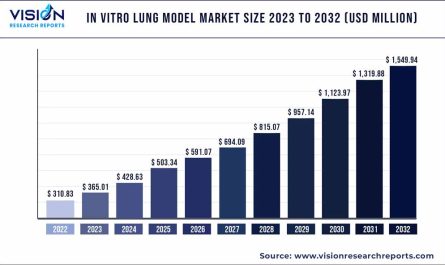The U.S. cell culture market size was reached at around USD 5.64 billion in 2023 and it is projected to hit around USD 14.7 billion by 2033, growing at a CAGR of 10.05% from 2024 to 2033.

Key Pointers
- By Product, the consumables segment held the largest revenue share of 59% in 2023.
- By Product, the instruments segment is expected to witness significant growth at a promising CAGR from 2024 to 2033.
- By Application, the biopharmaceutical production segment generated the maximum market share of 32% in 2023.
- By Application, the diagnostics segment is expected to expand at the highest CAGR from 2024 to 2033.
Understanding Cell Culture
Cell culture refers to the process of growing cells outside their natural environment, typically in a controlled laboratory setting. This technique allows researchers to study cell behavior, conduct experiments, and produce various biotechnological products.
Importance of Cell Culture in Biotechnology
Cell culture plays a pivotal role in various fields such as pharmaceuticals, biotechnology, regenerative medicine, and academic research. It enables the production of vaccines, monoclonal antibodies, recombinant proteins, and cell-based therapies, among other applications.
Get a Sample@ https://www.visionresearchreports.com/report/sample/41343
Factors Driving Market Growth
Advancements in Biotechnology
Technological advancements such as 3D cell culture, microfluidics, and automation have revolutionized the field of cell culture, enabling high-throughput screening, precision medicine, and personalized therapies.
Increasing Demand for Biopharmaceuticals
The growing prevalence of chronic diseases, rising healthcare expenditure, and the shift towards biologics have fueled the demand for biopharmaceuticals, driving the expansion of the cell culture market.
Technological Innovations in Cell Culture Techniques
Innovations in cell culture media, serum-free formulations, and single-use bioreactors have enhanced cell culture efficiency, scalability, and reproducibility, thereby accelerating research and development activities.
Challenges and Constraints
Contamination Issues
Contamination remains a major challenge in cell culture, affecting experimental outcomes, data reliability, and product safety. Contamination sources include microbial, viral, and cross-contamination from other cell lines.
Regulatory Challenges
Stringent regulatory requirements pertaining to cell culture practices, quality control, and product validation pose challenges for market players, necessitating compliance with Good Manufacturing Practice (GMP) guidelines and regulatory standards.
High Costs Associated with Cell Culture
The high costs of cell culture equipment, consumables, and maintenance, along with the need for skilled personnel and specialized facilities, contribute to the overall cost of biopharmaceutical production and research.
Opportunities for Expansion
Rising Investment in R&D
Increased investment in research and development activities by biotechnology companies, pharmaceutical firms, and government agencies is driving innovation and expanding the scope of cell culture applications.
Growing Applications in Drug Discovery and Development
Cell culture models are increasingly used in drug discovery and development processes for efficacy testing, toxicity screening, pharmacokinetics, and drug metabolism studies, offering faster and more reliable results compared to traditional methods.
Emerging Trends in Stem Cell Research
Advancements in stem cell technology, including induced pluripotent stem cells (iPSCs), organoids, and organ-on-a-chip platforms, are opening new avenues for disease modeling, drug screening, and regenerative medicine applications.
Read More: https://www.heathcareinsights.com/digital-health-for-cardiovascular-market/
U.S. Cell Culture Market Key Companies
- Sartorius AG
- Danaher
- Merck KGaA
- Thermo Fisher Scientific, Inc.
- Corning Inc.
- Avantor, Inc.
- BD
- Eppendorf SE
- Bio-Techne
- PromoCell GmbH
Recent Developments
- In March 2023, Danaher and the University of Pennsylvania unveiled a strategic alliance aimed at advancing cell therapy. This multi-year partnership focuses on developing new technologies, streamlining manufacturing processes, and delivering next-generation engineered cell products to patients, with the goal of achieving more consistent clinical outcomes.
- In February 2023, Thermo Fisher Scientific and Celltrio announced a collaborative effort to offer clients in the biotherapeutics industry a fully integrated cell culture system, providing precise control over the culture environment.
- In the same month, Corning Incorporated showcased its latest advancements in automation and 3D cell culture technology at the Society for Laboratory Automation & Screening (SLAS) conference in San Diego, California.
U.S. Cell Culture Market Segmentation:
By Product
- Consumables
- Sera
- Fetal Bovine Serum
- Other
- Reagents
- Albumin
- Others
- Media
- Serum-free Media
- CHO Media
- HEK 293 Media
- BHK Medium
- Vero Medium
- Other Serum-free Media
- Classical Media
- Stem Cell Culture Media
- Chemically Defined Media
- Specialty Media
- Other Cell Culture Media
- Serum-free Media
- Sera
- Instruments
- Culture Systems
- Incubators
- Centrifuges
- Cryostorage Equipment
- Pipetting
By Application
- Biopharmaceutical Production
- Monoclonal Antibodies
- Vaccines Production
- Other Therapeutic Proteins
- Drug Development
- Diagnostics
- Tissue Culture & Engineering
- Cell & Gene Therapy
- Toxicity Testing
- Other Applications
Buy this Premium Research Report@ https://www.visionresearchreports.com/report/checkout/41343
You can place an order or ask any questions, please feel free to contact sales@visionresearchreports.com| +1 650-460-3308

